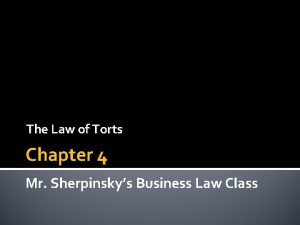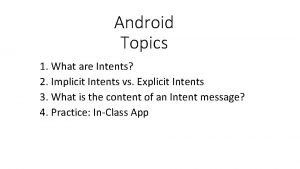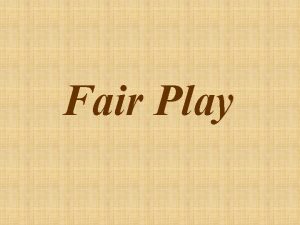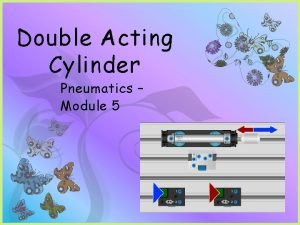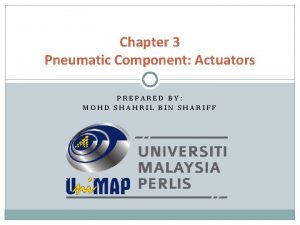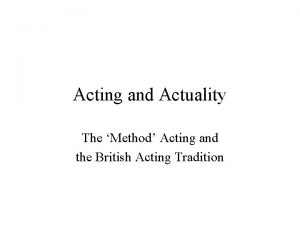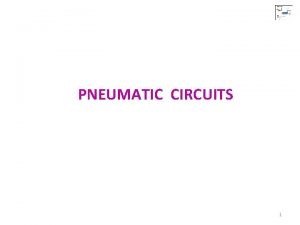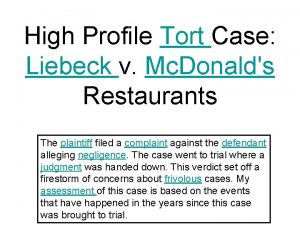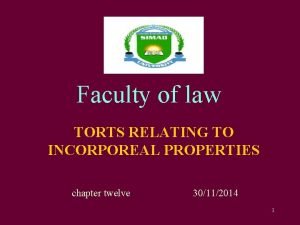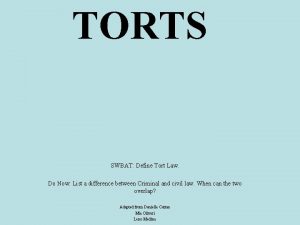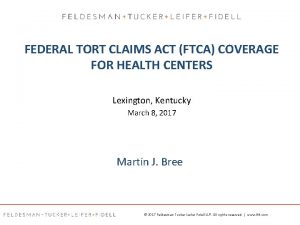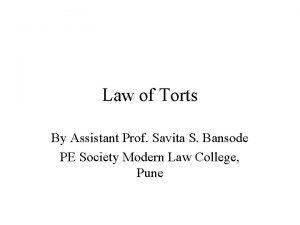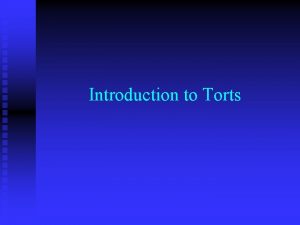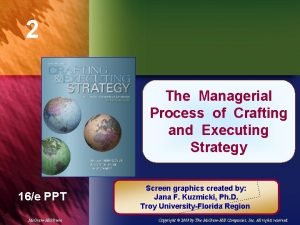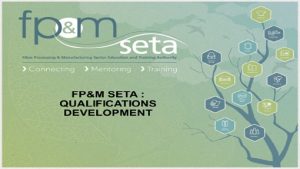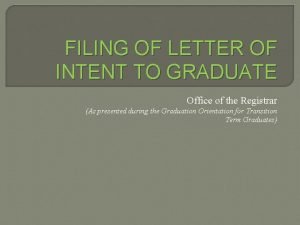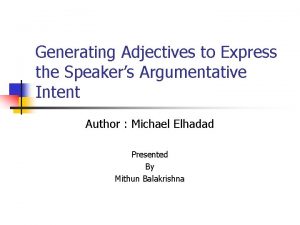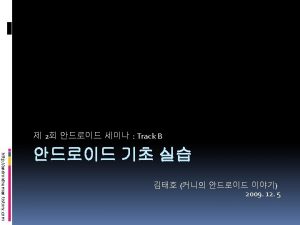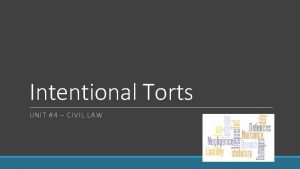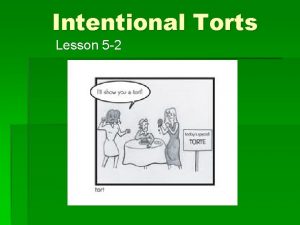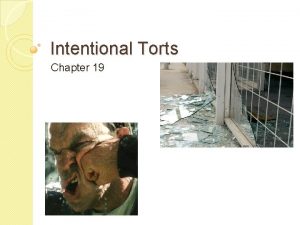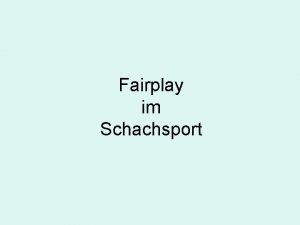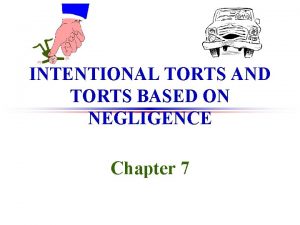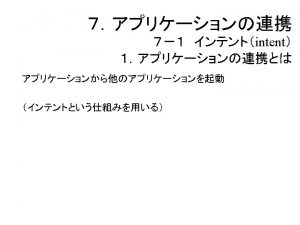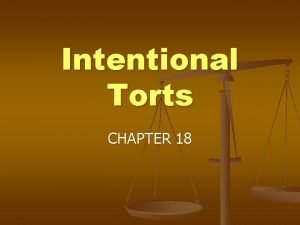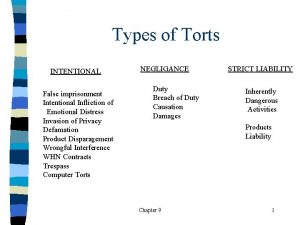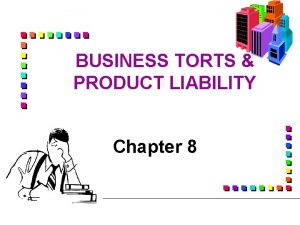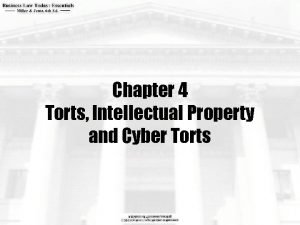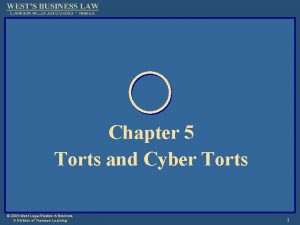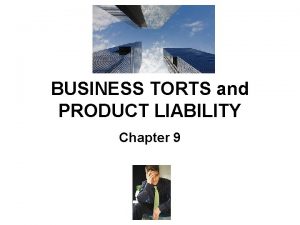INTENTIONAL TORTS Fairplay Intentional Torts Acting with intent





















- Slides: 21

INTENTIONAL TORTS

¡ Fairplay

Intentional Torts ¡ Acting with intent – planning to perform an act and then committing the act. l l ¡ In tort law, intent is not enough. Act must be committed. INTENTIONAL TORTS: actions taken to deliberately harm another person or their property l l Injury to person Injury to property

Types of Damages ¡ Compensatory damages – award compensates (makes up for) damages for harm caused by defendant l l l Lost wages Pain and suffering Must prove future losses (medical bills, reduced/lost wages, pain/suffering) with reasonable certainty

Types of Damages ¡ Nominal damages – token amount of money awarded by the court to show that the claim was justified. l l l Symbolic awards of money that are paid even if the plaintiff is unable to prove Defendant acted wrongfully (substantial injury/loss does not need to occur) $1

Types of Damages ¡ Punitive Damages – amounts of money awarded to the plaintiff to punish the defendant for malicious, willful, or outrageous acts. l l Warning for others not to do similar acts Nominal & Punitive damages can both be awarded ¡ Shooting at someone, but missing

Torts That Injure Persons ¡ Battery – a person intentionally causes a harmful or offensive contact with another person l l Perpetrator is liable for resulting damages, regardless of whether he/she expected the contact to cause injury What is offensive? ¡ Would “average” person in society find action offensive? l Kissing a stranger? ? ?

Torts That Injure Persons ¡ Assault – when a person goes beyond words and intentionally makes someone fear an immediate harmful or offensive conduct. l ¡ Intentional threat, show of force, or movement that causes reasonable fear To prove: l Fear of harmful/offensive contact must be reasonable/well-founded.

Torts That Injure Persons ¡ Infliction of Emotional Distress l l Relatively new (since 1940) Intentionally using words or actions that are meant to scare someone or cause them extreme anxiety or emotional No physical injury is required Plaintiff must prove Defendant’s actions were “quite outrageous” ¡ Plaintiff has sustained “extreme distress” ¡ l l Restaurants, hotels, bill collectors, insurance adjustors Other examples?

Torts That Injure Persons ¡ False Imprisonment – intentionally or wrongfully confining another person against his/her will l l Detaining someone Girl fight on You Tube

Torts That Injure Persons ¡ ¡ Torts related to Defamation (acts that harm a person’s reputation and can be classified as oral or written) Occurs when false statements are communicated to a third party, causing harm to their reputation l l ¡ Slander – oral statements ¡ More difficult to prove Libel – written defamation If you are a public figure, you must prove malice (intent to cause harm).

Torts That Harm Property ¡ Tort law provides two protections 1. Protects against interference with owner's exclusive use of property 2. Protects against property being taken and damaged

Types of Property 1. Real property (land the items attached to it) ¡ 2. Personal property (property that can be moved) ¡ 3. Examples? Intellectual Property (the ownership interest in creations of a person’s mind) ¡ Examples?

Real Property ¡ Trespass – occurs when a person enters another person’s property without permission. l ¡ Can recover damages even if no harm is done to the property. Situation- child too young to appreciate a dangerous situation? l l l Pools, construction sites Owner must use reasonable care to eliminate a dangerous condition “attractive nuisance” – construction companies generally fence in excavation sites

Real Property ¡ In cases of non-trespassers: l ¡ In cases of business-owners: l l ¡ You have a duty to notify of unsafe conditions. Reasonable care to make it safe for customers “Wet Floor” signs; shovel sidewalk Nuisance: unreasonable interference l l What is “unreasonable”? Injunction – order from the court for the defendant to stop all interfering activity.

Personal Property ¡ Conversion – occurs when someone unlawfully exercises control over the personal property of another l l ¡ Stealing property Could include both criminal and civil charges Reasonable force can be used to protect personal property l Deadly force?

Intellectual Property ¡ Patent – legal recognition of ownership of invention l l l l Machines, processes, new products Can include an idea for invention as well Novel – idea must be new in order to receive patent Lengthy legal process to obtain Legal monopoly for 20 year Seeds – Monsanto Farmer’s

Intellectual Property ¡ Copyright – legal recognition of ownership of expression l l l No lengthy legal process – fill out form Immediately effective U. S. Supreme Court: ¡ Life of creator, plus 70 years Article 1, Section 8: Congress can extend life of copyright Does not need novelty only “spark of creativity” Owner has exclusive rights to derivative works ¡ Works very similar to copyright

Intellectual Property ¡ Copyright continued… l l ¡ First sale- once the copyright owner sells a copy of the work, the lawful owner of the copy may resell that particular copy Fair Use: allows limited legal reproduction of copyrighted works for certain noncommercial purposes ¡ Critique, education ¡ Can legally copy free broadcast material ¡ Ripping and burning = illegal ¡ Conversion to MP 3 s and old Napster = illegal Infringement – the illegal use of someone’s intellectual property

Defenses to Intentional Torts ¡ Consent: plaintiff agreed to harmful conduct and gave up right to sue l l ¡ Privilege: justification of conduct that would otherwise be a tort l ¡ ¡ Written, spoken, simply assumed Children playing, athletic competition Legal authority (police restraining liberty of suspect) Self – Defense of Property

¡ Fracking
 Intentional tort examples
Intentional tort examples Implicit intent vs explicit intent
Implicit intent vs explicit intent Fairplay house essex
Fairplay house essex Miroslav klose fairplay
Miroslav klose fairplay Double acting cylinder control
Double acting cylinder control Difference between single acting and double acting
Difference between single acting and double acting Pantomimish
Pantomimish Single acting cylinder hydraulic circuit
Single acting cylinder hydraulic circuit Tort in healthcare
Tort in healthcare Torts case
Torts case Torts relating to incorporeal personal property
Torts relating to incorporeal personal property Definition of law of torts
Definition of law of torts Ftca coverage
Ftca coverage Law of torts
Law of torts Torts class
Torts class A company exhibits strategic intent when
A company exhibits strategic intent when Intent://main?tab=hot?dp_detail=top
Intent://main?tab=hot?dp_detail=top National letter of intent sample
National letter of intent sample Qcto letter of intent
Qcto letter of intent Declaring intent lol
Declaring intent lol Argumentative intent
Argumentative intent Emory ras intent to submit
Emory ras intent to submit
